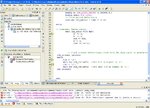Arrowspace
Banned

what is difference between Structural, behavior and test bench in VHDL?
Follow along with the video below to see how to install our site as a web app on your home screen.
Note: This feature may not be available in some browsers.






Code VHDL - [expand]
Code VHDL - [expand]
Not sure this is as easy to do in VHDL. Verilog was designed to model transistor level logic. It includes as part of the language nmos, pmos, cmos, etc. It also supports 8 levels of drive strength from high impedance...to supply rail. I imagine by now someone has written a package that tries to address some of this for VHDL.i have done it using verilog. i think it is possible with vhdl alsoCan i do transistor level modelling in VHDL

Your CLA_Addr instance is incomplete, it ends on the line cout => cout, where is the closing );?
For a 4-bit shift register...
Structural modeling:
Code VHDL - [expand]
For behavioral modeling:
Code VHDL - [expand]
Now which way is easier to see what is being implemented?
Not sure this is as easy to do in VHDL. Verilog was designed to model transistor level logic. It includes as part of the language nmos, pmos, cmos, etc. It also supports 8 levels of drive strength from high impedance...to supply rail. I imagine by now someone has written a package that tries to address some of this for VHDL.
Code VHDL - [expand]





What are you expecting? And how do you propose to calculate the time it takes to perform an add with combinational logic in a functional simulation? Any timing delays in the code aren't synthesizable nor are they representative of the actual implemented design timing.Ok , my problem get solve , but new problem with that I want to calculate time consume by adder to perform full task , but my simulation window always showing 1us and multiple of 1us





